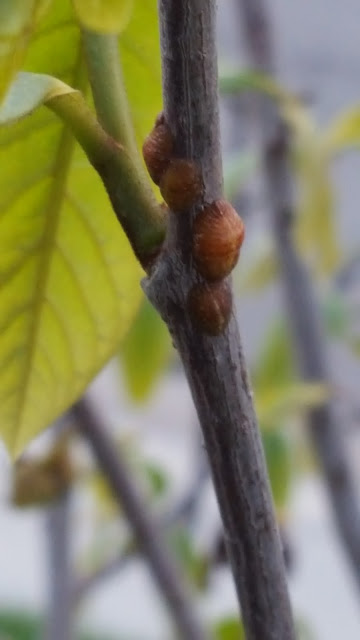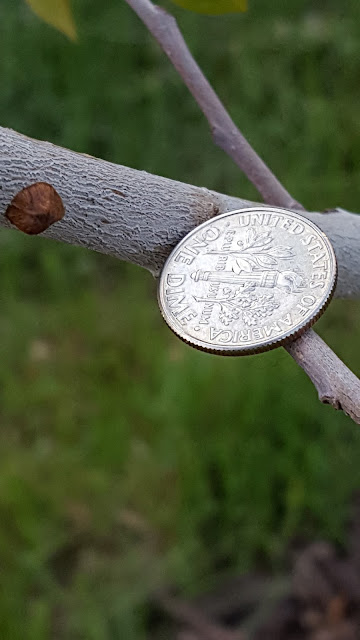I've frequently read that pawpaws have very few if any pests. Often people will only mention one: the
zebra swallowtail butterfly, but then in the same breath they'll say that some people plant pawpaws specifically to attract the butterflies. On the
Peterson pawpaw page, the list of pests is a bit more extensive: the Pawpaw Peduncle Borer, leaf spot caused by fungus, occasionally slugs, and also of course the Zebra Swallowtail. People say the pawpaw's leaves and bark are too full of toxins to be palatable to most pests.
So yesterday evening I was surprised to be looking at our KSU-Atwood pawpaw tree and find the branches hosting several bumps--they weren't leaf or flower buds, and I picked one off and it was slimy inside, kind of yellowish, but it didn't have a smell. What could it be, I thought? But then I needed to run off to the pinewood derby.
So this morning after our run, NJ and I looked at the pests and spent several minutes removing all we could find from the KSU-Atwood. We also noticed that they were also (in lesser numbers) on the Wells and the Shenandoah. Here are some pictures.
 |
| They seemed most common on the outer extremities of the branches. And they often were in clusters. |
 |
| For perspective, you can see their size compared to a dime. |
 |
| On their exterior, they had a type of skin. |
 |
| When we picked them off the tree, the skin was pliable and generally stayed in tact, but the inside, the part in contact with the branch, was slimy. |
 |
| Here are some more. |
 |
| So you can see, this infestation is happening while the tree is still flowering, and while it is beginning to develop fruit. |
 |
| Close-up of one. |
 |
| With a dime for perspective. |
 |
| Some final pics with the collection I picked off the branches. |
Searching for more information this morning, I'm finding that these look like "
scale insects," which I gather are pests because they eat the sap of the tree and hence sap its strength. And they can cause mold at the places where they been. Here's a
document prepared by a Utah State University extension entomologist, which helps me identify these as "brown soft scale."
I've only been able to find a very few mentions of pawpaws hosting scale insects:
here,
here, and
here. So it seems like scale insects on pawpaws isn't a very documented problem.
I'm so surprised!

























I've seen a terrible problem with scales on pawpaw trees growing at an old tree nursery that is no longer in operation. It probably collected the scales along with many other infestation problems over years of commercial useage.
ReplyDeleteThanks WWalker. Interesting to know about this scale insect infestation at the nursery. In my next post, I mention our solution for this year. So far so good--we just got back from an eight day trip to New Mexico and didn't see any scales on the branches when we got out of the car this morning.
DeleteI just ordered four trees that had two with one each of of these scales, thanks for your posts so I could quickly identify and remove them :-)
ReplyDeleteJust noticed my 18yr old Illinois Everbearing mulberry tree is loaded w/ red scale😣, so far none on my pawpaw which are right next to it. I usually take the organic rout but for this, may have to use chemicals. I'm in DE.
ReplyDeleteThis comment has been removed by a blog administrator.
ReplyDeleteExcellant info and also perfect photos to show size and shape...got me to check mine here in Sacramento!! Only found a few before but a good reminder to keep checking...thank you!
ReplyDeleteThis pest is Parthenolecanium corni. I know it's a bit late my answer but maybe someone else will need this information like I did today.
ReplyDelete